Many people think that Paella (pie-eh-ya) is the Spanish national dish (along with slightly lesser known, Arroz a Banda and Arroz Negro), however, they would be mistaken, because these rice dishes all hail from the province of Valencia.
The Moors began cultivating rice in Spain, perhaps as far back as the 8th and 9th Centuries and the marshes and lagoon of L’Albufera, (in the south of Valencia) proved to be a perfect place for paddy fields (though rice is cultivated all over Spain). Originally rice dishes would have been cooked in cauldrons or terracotta cazuelas – soupy stews of fish or meat, such as a Caldero Murciano or oven baked meat and rice with beaten eggs on top like Arroz con Costra. Paella became popular from about 1840 onwards and takes its name from the pan it’s cooked in – a wide but shallow cast iron frying pan with handles on either side, ideal for cooking outdoors over a wood fire which provides a smokey flavour. Having become extremely popular with Spaniards and tourists alike, versions of paella can be found all over Spain and as far afield as British supermarkets. Much to the consternation of Valencian chefs and traditionalists, the fairly specific regional ingredients have become adapted, often mixing fish and meat – the worst transgression being the addition of chorizo, which is not found in any of the above mentioned rice dish recipes. Some of the “best” British celebrity chefs have played a big part in adulterating Spanish regional food. There were 6 pages of critical comments, regarding the use of chorizo in this paella recipe, which has since had the chorizo and comments removed!
To defend against the bastardisation of their regional food heritage, an organisation of Valencian celebrities from the world of culture, gastronomy and society has been set up, called Wikipaella. Their aim is, “To encourage knowledge and acknowledgement of authentic paellas.”
They have 10 golden rules for making an authentic Valencian Paella:
1. Don’t mix seafood and meat. And only use seafood if by the sea.
2. True Valencian paella is made with rabbit, chicken and green beans in the summer, duck and artichoke in the winter.
3. No garlic. No peas. No potatoes. No stock. NO CHORIZO.
4. Only use Spanish rice, preferably Valencian bomba or senia.
5. Cook over wood, for that authentic smoky flavour.
6. On no accounts, stir. The rice should stick to the pan.
7. Oh, and that pan should be an authentic paella. Not a frying pan. And definitely not a wok.
8. Eat it straight from the pan, preferably using a wooden spoon. At lunchtime only.
9. If it’s served in a portion for one, it isn’t the real thing, it’s been frozen and reheated. Or it’s from Vesta.
10. For ultra-authenticity, it should only be cooked by a man. A Spanish man. In Valencia.
Having read the rules, how would I dare to make a paella in London? Since I don’t have a paella pan, or an open fire and I’m not in Valencia or remotely Spanish, the next best thing, would be to make a rice dish inspired by the common ingredients of the genuine article. The paellera (pan) isn’t really suited to a home cooker anyway, having been originally designed for an open fire of pine or orange branches. In modern professional kitchens or at outdoor events, outsized gas burners are used to spread the heat out across the entire pan for even cooking. So instead, I used my Spanish terracotta cazuela – a cooking dish in common use throughout the Roman Empire (2000 years ago) and still very much a useful Spanish kitchen cooking pot today.
Arroz de Faisán y Conejo (Pheasant and Rabbit Rice) recipe (serves 3 – 4):
a very generous pouring of Spanish extra virgin olive oil
500g pheasant (legs and breast)
500g wild rabbit (legs, saddle and liver)
200g green beans (chopped into 2cm pieces)
1 large Spanish tomato (or 3 English sized ones)
6 pieces of garlic (chopped)
a heaped spoonful of pimentón de la Vera dulce
1.5 – 2 litres water
1/2g saffron
1 sachet food colouring
a branch of rosemary
400g Valencian rice (bomba or senia)
sea salt to taste
I bought a rabbit at the farmers’ market and had a pheasant in the freezer. Since, in spite of the paella rules, there is some flexibility in ingredients and differences in recipes on the Wikpaella website – duck is sometimes used as well as, or in place of chicken and I could imagine a Valencian farmer using another shot game bird instead. Apparently water vole was used in early recipes. Similarly, outside the rules, most sample recipes include garlic!
To start, season with salt and brown the meat in plenty of Spanish extra virgin olive oil, holding back the rabbit liver. I recommend buying wild rabbit, farmed rabbit is treated worse than battery chicken – there are few regulations for farming rabbits.
When the meat is nearly ready, fry the liver for a couple of minutes and remove to a plate – there’s no need to overcook it.
If I had a 45cm paellera, I’d push the meat to the edges and continue with the vegetables in the middle. Since the cazuela is deeper, but less wide, I removed the meat to a plate so as to fry the green beans (judías verdes) for 5 minutes or so.
Here’s a good Spanish trick – instead of blanching and peeling tomatoes, it’s easier to cut them in half and grate the cut side into what you are cooking.
It’s very quick – all the goodness goes into the recipe and you are left with empty flat skins.
Follow the tomato with finely chopped garlic
and when it has softened, sprinkle on a heaped teaspoonful of dulce Pimentón de la Vera. Give this a stir and return the meat to the cazuela.
Pour on 1 litre of water – I used boiling water to speed things up. When the liquid is bubbling, mix in the butter beans – mine were presoaked and cooked in a pressure cooker beforehand. If using a paellera, the water would go up to the top of the rivets in the handles.
Turn up the heat and reduce the stock to almost nothing.
Pour on more boiling water (to the nails [rivets], as they say) and taste – add more salt if required. Pour a little boiling water on the saffron before stirring it in to the stock. Your kitchen should be infused with a fabulous crocus aroma.
I noticed that some of the paella recipes used food colouring and I just happened to have the real thing (bought in Valencia) in my cupboard, thanks to Sue.
Note the beautiful packaging,
reminiscent of Beecham’s Powders! This is tartrazine (A.K.A. E102) and corn flour. Curcumin might be a more organic alternative.
With the saffron and colouring added, pour the Valencian rice into the cazuela. Stir this in, so that it’s evenly mixed, but do not stir again!
Put the rosemary branch into the middle of the broth and leave it there for 3 minutes only. If cooking snails in a paella, you don’t use rosemary, because snails eat it and therefore contain an essence of rosemary already.
Simmer the dish vigorously for about 10 minutes before turning the heat right down for a final 10 minutes.
The stock should all be absorbed and rice will have a brilliant yellow colour.
Place a newspaper on top of the cazuela (making sure the gas is switched off) for 5 minutes, to allow any remaining liquid to be soaked up and the dish to settle.
A good paella is judged by the dark crust (socarrat) that forms at the bottom of the pan. I’m careful not to let the rice get too dry in terracotta or the cazuela will crack, but you can see evidence of the crust forming in the above picture.
Paella is a lunchtime dish, it should be served warm (not hot!) and eaten direct from the pallera with a wooden spoon. I enjoyed my Arroz de Faisán y Conejo with an organic Valencian tempranillo, Casa Lluch. Historically, paella and rice dishes were not served with allioli, but in recent years it has become common practice. I made my own, since I like a bit of allioli on the side.
As an experiment, when I heated up leftovers today, I added a little chopped fried chorizo to see how it affected the taste. While the rice was still quite enjoyable, the chorizo dominated all the flavours and in particular, completely smothered the flowery sweet and bitter saffron. Conclusion – chorizo does not belong in a paella!

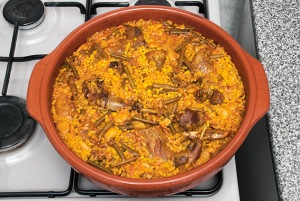
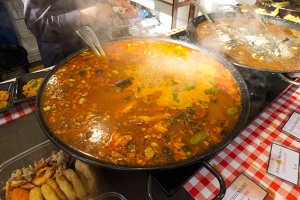
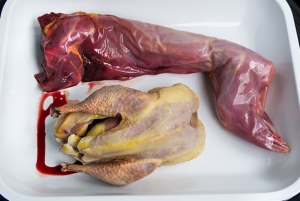
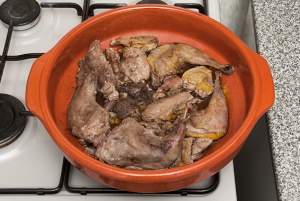
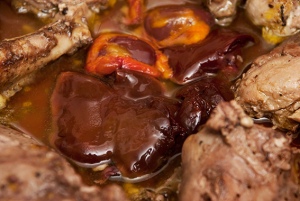
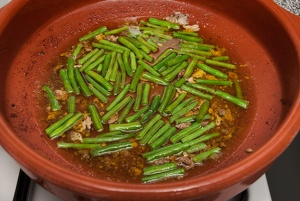
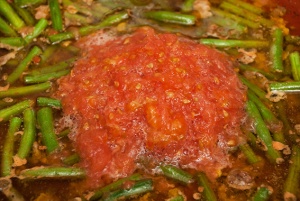
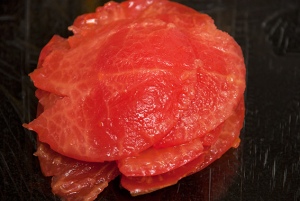
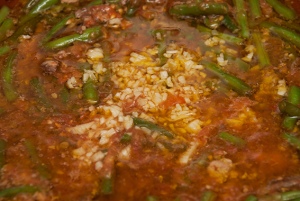
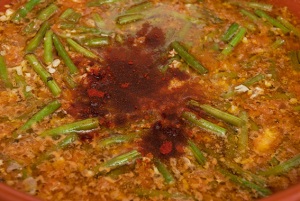
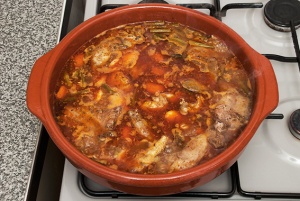
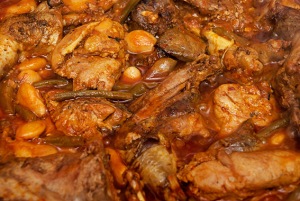
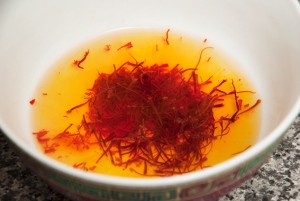
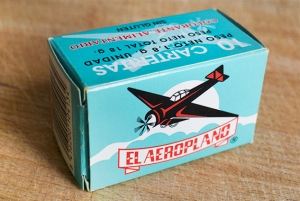

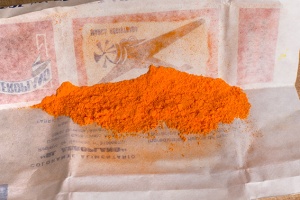
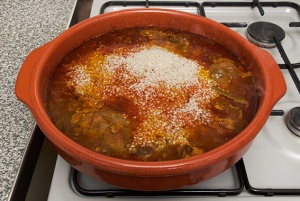
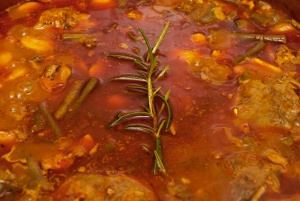
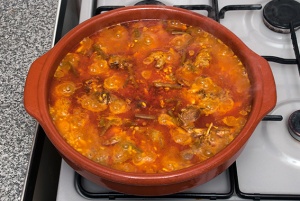
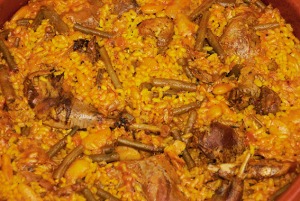
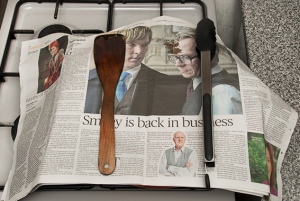
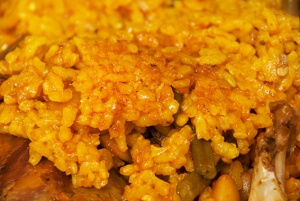

When next i come we must away to the Moors (sorry play on words – bad form) and have paella! And I MUST have a good paella pan. I will bring an empty suitcase!
That sounds like a fabulous idea!
We may have to hop on a plane of course! With our lovely friend!
That’s a plan!
* smile* Amazon has a brilliant and quite cheap paella pan, burner and stand kit – why not put it into you ‘Amazon’ book ?
Oh, what a fabulous post, Mad!!!! Here is my ‘homework’ for the weekend – mean to look up each and every link! Now pheasant I cannot easily get in this neck of the woods but mean to copy your recipe exactly when I can get another 3-4 foodie friends for a long lunch and work out the best alternate!! Am laughing about your ten golden rules – knew not to mix seafood and meat, the no stirring but building up a crust and having it at lunch! Hate peas, so that is fine . . . always have used garlic [hmmm!] . . . . have used stock [oops!] . . . . don’t remember, but chorizo may have been ‘there’ sometimes . . . And, oh dear, having had a Hungarian husband for a brief time in my life, am very used to the concept that only the male of the species knew how to cook properly . . . in his case curries and goulash 🙂 ! Well, the laugh is on me now . . . .
Thanks Eha – for my recipe, any game bird will do. Chicken and rabbit are staples in the traditional recipes. Duck is used in winter, with artichokes. You might have to poke around on the Wikipaella website to see the % use of ingredients and differences in recipes for examples, but pork ribs and meatballs are allowed too, in combination with chicken and rabbit. Arroz a Banda, the fish one, does use stock. I hope that helps.
*smile* – Thanks but methinks no Wikipedia needed for the recipe!! Like yours and shall reach for the nearest game bird !!! Love the idea of eating straight from the pot: kind’of similar to the Japanese ways of which I am so fond . . . .have a great weekend, we are being blown apart by freezing gales after a 30C beginning to spring . . .
Wowowow! This is very valenciano. I happen to like game. Rabbit and pheasant are so homey. I like the rules and you did a great job from afar. This is an impressive history and recipe. Dishes like this are what sparked my cooking and started the blog. So good! Thank you for sharing this. Be well!
Thanks Amanda – I love things like this where a food has been created in a certain place, but the origins are from afar. It’s not just the rice, what on earth did we eat before tomatoes and pimentón from the Americas?
Superb recipe!!!!
Thanks Nadia!
We have a paella burner and pan and your post made me smile…I usually do the prep and then at the last minute (outside) Big Man steps in for the final flourishes and gets all the credit (very much like the British bbq scenario)! In Andalucía we do stir, although 6prefer it when it sticks and as you say, never, never chorizo!! Fabulous recipe, great post 😀
Thanks Tanya – I’m a bit jealous of your pan and burner. I’ve noticed that in rural Spain, it’s not uncommon to have a large fireplace or the burner in the kitchen or even in an outhouse, something that is long gone here, but there are recipes which taste much better cooked the old way, including roast meats. My parents had an ancient kiln oven which they bricked up and painted over – sacrilege!
Will have to dig out my chapter about cooking in the outhouse! But yes, a lot of our friends and family have an open fire they can cook on. They have these little three legged trivet things to stand the pan on, over the hot ashes. It does add something special to the flavour! We can cook on a parilla (would you call it a metal grill thing you can clamp together?!) in our fireplace at the Cortijo in Spain. Shame about the kiln oven, but I guess when they did that, no one was into wood burning ovens!
That definitely beats a little wooden shed at the bottom of the garden. You’d think les rosbif could have managed to keep some form of meat roaster, but sadly the oven proved too tempting. I need an outhouse in Spain 😉
My dad chopped up the beautiful old pine table and matching dresser too, then burnt them in the garden. As a ten year old I was horrified!
I do hope we will see your book published one day soon…
Pingback: Pheasant Curry | Mad Dog TV Dinners
Pingback: Pheasant Stuffed with Garlic and Olives | Mad Dog TV Dinners
Pingback: Pheasant with Chorizo and Pimentón | Mad Dog TV Dinners
Pingback: Pheasant and Morcilla | Mad Dog TV Dinners
Pingback: Pheasant in Mushroom and Cream Sauce | Mad Dog TV Dinners
Pingback: Roadkill | Mad Dog TV Dinners
Pingback: Roast Pheasant | Mad Dog TV Dinners
Pingback: Spatchcock Pheasant with Harissa | Mad Dog TV Dinners
Pingback: Pheasant with Stilton Sauce | Mad Dog TV Dinners
Pingback: Rabbit Barbecue | Mad Dog TV Dinners
Pingback: La Bodegueta | Mad Dog TV Dinners
Pingback: La Braseria | Mad Dog TV Dinners
Pingback: Brunswick Stew | Mad Dog TV Dinners
Pingback: Chicken and Rabbit Chilli | Mad Dog TV Dinners
Pingback: Joanet (revisited) | Mad Dog TV Dinners
Pingback: La Mar Salada (revisitado) | Mad Dog TV Dinners
Pingback: Topik | Mad Dog TV Dinners
Pingback: Turkey Fiesta | Mad Dog TV Dinners
Pingback: Wild Rabbit (roasted) | Mad Dog TV Dinners
Bring on that dark crust!
Yes indeed – the socarrat is the best bit!
Pingback: Pheasant and Rabbit Casserole | Mad Dog TV Dinners
Well, I’ve made paella and eaten paella in Spain but now I read that none of it was really paella. Your version, whatever you want to call it, must have been great tasting.
Thanks Karen – I think the Valencians are just trying to quantify what their regional dish really is, having had it usurped by the rest of Spain and Europe. The British supermarkets and celebrity chefs are quite guilty of using ad hoc ingredients which completely change the taste. There’s nothing wrong, however, in throwing some ingredients together and making a Spanish rice dish 😉
Pingback: Tiella | Mad Dog TV Dinners
Pingback: Tielle à la Sétoise – Octopus Pie | Mad Dog TV Dinners
Pingback: Fideuà | Mad Dog TV Dinners